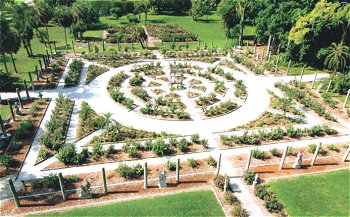Ringling Grounds
trees, Ear trees -male and female- and the Sausage tree with hanging tendrils and dangling sausage-like pods. A large Arborvitae planted by them still grows near their house. Royal Poinciana and Jacaranda trees nearby were planted after the Ringling Era. Aside the road near the Rose Garden is a Toong tree from China whose berries could be boiled and rendered into an oil used in the treatment of wood furniture as found in Formby's Furniture oil.
John and Mable Ringling also received plantings as gifts from many prominent people. Thomas Edison, who had been introduced to Banyans by Harvey Firestone, gave the impressive Banyan trees to John Ringling. Harvey Firestone used banyan trees, a Ficus, while experimenting to find a feasible source of latex. Mrs. Potter Palmer gave Mable Ringling the great stand of Bamboo near the Bay and House.
A fruit nursery was located on both sides of the road leading to Ca'd'Zan near the Caretakers Cottage. The Ringlings raised Citrus, Star Fruit and Mangoes for their own use. The only remaining tree from that nursery is a Mango found on the left side of the road. Another Mango near the Cottage is one of the largest in Florida. Also, a Macadamia tree in this area was planted by John Ringling and is the largest in Florida and so immensely popular with squirrels that personnel are unable to harvest the nuts. Near the House, leaning towards the Bay, is an original Cedar that is at least 125 years old.
Some floras on the grounds "No one planted". Many of these are shrubs located along the southern perimeter of the property. These include the Beauty Bush with' deep lavender clustered berries used in floral arrangements. The Bishop's Cap (Hibiscus), Polk Berry, Wild Grape, Buffalo Grass, Mimosa and Willow tree also flourish in this dense brush area.
Near the Shell Parking Lot is a collection of trees that "Had to have been planted". They are Soap Berry tree, Red Mulberry and Black Locust. Ringling Horticulturist, Ron Mallory, believes it is an unusual grouping of trees for Southern Florida, and therefore had to have been planted by someone yet unknown.
There are also the "Unwanted" on the grounds, including, Brazilian Pepper, Virginia Creeper, Poison Ivy and the Potato Vine, with potato-like fruit early settlers complained even their pigs wouldn't eat! Ron Mallory explained that flora needs not only to be replaced, but also maintained and this can be expensive. In areas where grass cannot grow, as under Banyan trees, he has introduced ground covers such as Purple Queen, and most successfully, ferns. In the last seven years he and his crew have planted 10,000 ferns.
Ron has discovered interesting characteristics of our Ground's floras. He has observed that Bamboo, in the grass family, has grown 3 to 4 inches a day and he has determined it is better to leave a few dead stems because they support new, live ones in strong wind. He is concerned about viruses that attack palms. He has a very special hybrid palm that is crossed from two different disease resistant varieties from opposite parts of the world - a Philippine Coconut Palm and a Panamanian Coconut Palm. He is curious to see if it will be resistant to disease in Florida. So far it is thriving and producing coconuts.
Preventing wind damage to our large trees is another important consideration. It is beneficial to thin trees to keep branches sparse and open so strong winds can flow through and not against them. Ringling Grounds with its varied floras is an integral pan of the Museum and much more than an attractive setting and backdrop for Ca'd'Zan and Museum buildings.
Ring-A-Ling paper, Fall 1999
More Information like the above.
